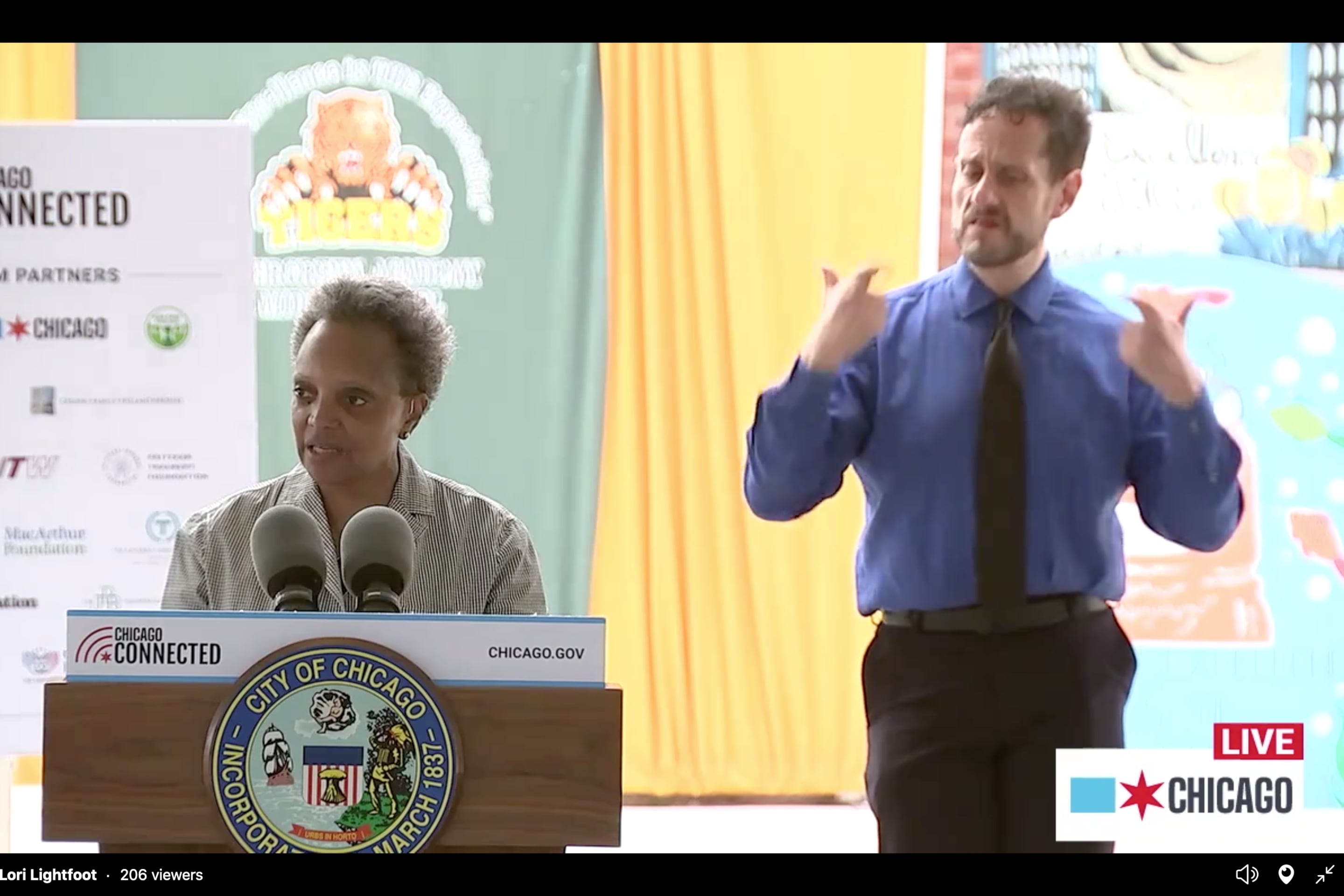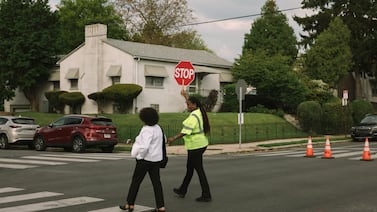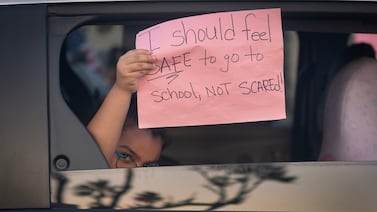The city of Chicago, donors, and internet service providers have struck a deal to expand internet access for Chicago students — what officials called a “groundbreaking” initiative that comes more than three months after the coronavirus pandemic shifted most learning online.
Under the plan, the city aims to provide free high-speed internet to an estimated 100,000 children in low-income households, paid for with donations and federal emergency coronavirus response dollars. The estimated cost over four years is $50 million.
Until now, Chicago had taken a hands-off approach to addressing internet access compared with some other urban districts. The district handed out more than 100,000 computers and provided mobile hotspot devices to homeless students. But otherwise, schools largely steered students to a 60-days free offer from Comcast. That approach drew concerns from some advocates, school board members, and the teachers union, who said some students remained disconnected from virtual learning and fell behind.
Mayor Lori Lightfoot’s office has lobbied internet service providers and donors to pitch in for a longer-term solution, at times calling out those providers publicly for not doing more. The agreement announced Thursday, which involves Comcast and RCN, marks the kind of public-private partnership that cities such as Los Angeles and Portland struck with providers earlier during the crisis.
But Chicago’s initiative goes much further than others and could serve as a national model, said Daniel Anello of the advocacy group Kids First Chicago, which took part in efforts to launch the initiative.
“Sixty thousand households is a huge lift for digital equity,” he said. “This is probably going to be one of — if not the — largest high-speed internet connection efforts in the country.”
An April study by Kids First and the Metropolitan Planning Council found that one in five Chicago children lacks internet access at home, with much higher rates in predominantly Black and Latino neighborhoods.
“‘Chicago Connected’ truly is a game changer,” Chicago schools chief Janice Jackson said at an event with Lightfoot to announce the initiative. “This is essential whether we return to a remote learning environment or not.”
Thursday’s announcement comes as Chicago gears up for all-virtual summer school — a chance for students to make up work they missed this spring — and a possible return to remote learning or a hybrid approach in the fall.
The first two years of the program will be funded by $5 million in federal coronavirus relief dollars and by donations from the Crown Family Philanthropies, the Pritzker Traubert Foundation, and others. Citadel founder and Chief Executive Officer Ken Griffin helped spearhead the initiative and contributed $7.5 million. President Barack Obama and his wife, Michelle Obama, chipped in as part of a joint $750,000 contribution as well.
Chicago Public Schools will cover the costs of the program in years three and four. United Way will administer the program, paying Comcast and RCN directly so that families do not receive a bill.
Lightfoot said the initiative, which will also help families apply for jobs and receive healthcare remotely, is key for the city’s efforts to reduce poverty and improve academic outcomes for students.
A push for a solution
In recent months, members of the Chicago district’s governing board have repeatedly pressed its leaders on their plans to broaden internet access. Sendhil Revuluri, the board’s vice president, said in an interview with Chalkbeat that the district succeeded in handing tens of thousands of devices to students who needed them, but he believes that effort missed students who are the hardest to reach.
And he said that ensuring those devices can connect to the internet and enable learning remains a challenge.
Referring families to free offers from providers such as Comcast likely left out students whose parents might be unable or reluctant to sign up because they don’t have a phone, don’t speak English, are undocumented, or have spotty credit records. Revuluri said he spoke with one principal who told him that his staff members spent an entire day trying to set up internet service for seven students.
Mueze Bawany, a teacher at Roberto Clemente Community Academy in the city’s West Town neighborhood, said he is glad that the new partnership will allow more students to sign onto the internet. He and his colleagues are still regularly hearing from students who lack access.
He said one of his students drove about 40 miles to a cousin’s home in Crystal Lake to use the internet for schoolwork. Several other students tuned into Bawany’s video classes from the parking lots of neighborhood businesses with public WiFi. Many used their cell phones to do schoolwork.
Still, he said for some Chicago students, this deal comes long after hurdles to participating in school remotely have caused them to disengage and fall behind.
“We had three months of kids who were anxious about this and scrambling to get by,” he said. “It’s a little too late for a lot of kids.”
Urban districts across the country have grappled with the task of quickly expanding student access to the internet, which proved a trickier challenge than buying and distributing computers. New York City handed out almost 300,000 internet-connected tablets to students, at a total cost of $269 million. Other districts, such as Houston, scrambled to get their hands on mobile hotspots, another costly approach hampered by major backlogs for ordering these devices.
Angela Siefer, executive director of the National Digital Inclusion Alliance, said making such devices available to students without stable housing is an important piece of the internet access puzzle. But ultimately, she said, broadband remains the most affordable and reliable solution. She noted Congress is eyeing proposals that would offer broadband subsidies to low-income households, but they have yet to draw bipartisan support.
She pointed to cities such as Portland, where the school district and philanthropic groups struck up an arrangement with Comcast in April to offer six free months of internet to low-income families and helped them sign up for the service. A slew of school districts also have partnered with T-Mobile to expand access.
In March, Los Angeles Unified School District teamed up with Verizon to offer internet service to an estimated 125,000 of its students.
But internet providers have been wary of giving away too much during the pandemic and setting a precedent, Siefer said.
“It’s important to recognize that in the U.S., internet service is a commodity, not a utility,” she said. “Whose responsibility is it to provide for these families? Comcast certainly has a responsibility, but the responsibility is not theirs alone.”
“A public good”
Chicago city and district officials have signaled for some time that they were pressing local service providers to do more. Lightfoot called them out last month, saying they should not “put their profits over the needs of people in low-income neighborhoods.”
On Thursday, she said her office would continue to work with providers in the coming months to make sure “they are living up to their commitments and obligations.”
Jack Segal, a Comcast spokesman, said before Thursday’s announcement that the company has already done a lot to respond to the coronavirus outbreak. It almost doubled speeds for its Internet Essentials low-cost service and allowed customers with unpaid bills to sign up for the 60-days free offer. The monthly price of $9.95 for Internet Essentials hasn’t changed since 2011.
Alderman George Cardenas, who joined Lightfoot at Thursday’s launch, said he has heard the sense of urgency in calls to address internet access from parents and others concerned about students falling behind. But he said taking the time to get the program right and draw extensive financial support was worth the wait.
Kids First and the Metropolitan Planning Council recommended in April the type of public-private partnership announced Thursday in their report quantifying the internet access divide in the city.
The goal is to connect as many of the 100,000 students identified as possible by the start of the coming school year.
Officials said they will begin outreach to families next week, giving priority to students enrolled in summer school. Students eligible for subsidized school meals, those with special needs, homeless students, and those living in high-need neighborhoods will also get priority.
More information is at cps.edu/chicagoconnected.
The city will enlist community non-profit organizations to help enroll families in the program and increase digital literacy.
“We’ll have to start thinking of the internet as a public good,” Anello of Kids First said, “and this is the first step toward that.”






